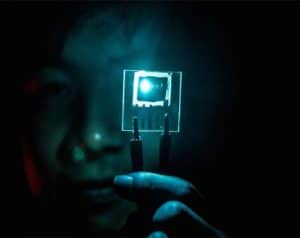 Jaesang Lee, Electrical Engineering PhD Student, demonstrates use of blue PHOLEDs in the EECS Building on August 13, 2014. The blue PHOLEDs were developed in EECS Professor Stephen Forrest’s lab groups and are for use in cell phones, tablets, and other electronics. The LEDs’ lifetime has been enhanced by a factor of ten, allowing for more efficient use. Credit: Joseph Xu, Michigan Engineering Communications & Marketing.
Jaesang Lee, Electrical Engineering PhD Student, demonstrates use of blue PHOLEDs in the EECS Building on August 13, 2014. The blue PHOLEDs were developed in EECS Professor Stephen Forrest’s lab groups and are for use in cell phones, tablets, and other electronics. The LEDs’ lifetime has been enhanced by a factor of ten, allowing for more efficient use. Credit: Joseph Xu, Michigan Engineering Communications & Marketing.
Stephen Forrest and a team of researchers at the University of Michigan collaborated and have discovered a development in blue OLEDs that could result in smart phones having a longer battery life and large-screen televisions using less power in the near future. The group has “have extended the lifetime of blue organic light emitting diodes by a factor of 10.” Improvements of Blue OLEDs mean an increase of efficiency by 5 – 20 percent in televisions and smartphones.
OLED’s are the piece of technology that permits screens on electronic devices to be thin and curved and to only have small amounts of blurring when objects move on the screens. “In these ‘RGB’ displays, each pixel contains red, green and blue modules that shine at different relative brightness to produce any color desired.”
“But not all OLEDs are created equal. Phosphorescent OLEDs, also known as PHOLEDs, produce light through a mechanism that is four times more efficient than fluorescent OLEDs. Green and red PHOLEDs are already used in these new TVs — as well as in Samsung and LG smartphones — but the blues are fluorescent,” the researchers said.
During experiments the research group spread out molecules that produce light energy and this stopped negative synergy from destroying the molecules and also caused the energy to spread out.
“Our university research programs are a strong element of our effort towards solving critical OLED issues and accelerating the growth of the display and lighting industries. This exciting result by Professor Forrest and his team is an important step towards a full commercial phosphorescent RGB solution,” Julie Brown, senior vice president and chief technical officer of Universal Display, said.





